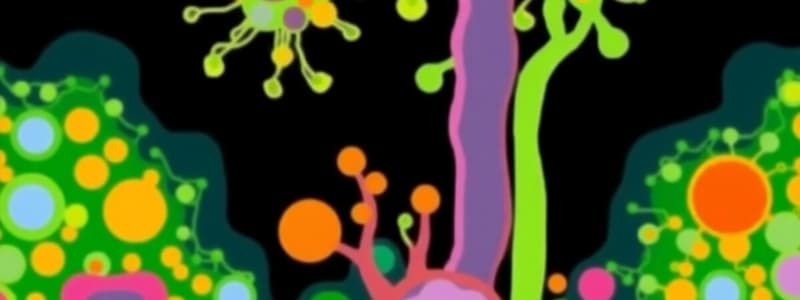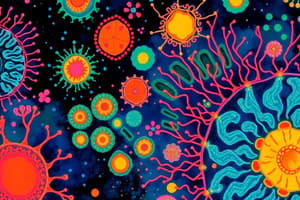Podcast
Questions and Answers
Which statement is true about Archaea?
Which statement is true about Archaea?
- Archaea are exclusively found in extreme environments.
- All Archaea have a two-layer lipid membrane.
- Archaea have larger sizes than most bacteria.
- Archaea possess a circular DNA genome. (correct)
What type of environments do Halophiles thrive in?
What type of environments do Halophiles thrive in?
- Anaerobic environments.
- High salt concentrations. (correct)
- Extremely hot and acidic waters.
- Extreme temperatures and pressures.
What is a primary characteristic of Methanogens?
What is a primary characteristic of Methanogens?
- They rely on sunlight for energy.
- They produce oxygen as a byproduct.
- They produce methane using carbon dioxide and hydrogen. (correct)
- They are found only in aquatic environments.
Which statement about bacterial reproduction is accurate?
Which statement about bacterial reproduction is accurate?
What structure do motile bacteria use for locomotion?
What structure do motile bacteria use for locomotion?
Which is NOT a main type of Archaea based on unique habitats?
Which is NOT a main type of Archaea based on unique habitats?
What is a common shape of bacteria?
What is a common shape of bacteria?
What is a plasmid?
What is a plasmid?
How many pounds of bacteria approximately live on or in the human body?
How many pounds of bacteria approximately live on or in the human body?
Which of the following sequences best represents the stages of evolution leading to living cells?
Which of the following sequences best represents the stages of evolution leading to living cells?
What hypothesis suggests that RNA was the first genetic material to evolve?
What hypothesis suggests that RNA was the first genetic material to evolve?
Which experiment is famously associated with the production of organic monomers under prebiotic conditions?
Which experiment is famously associated with the production of organic monomers under prebiotic conditions?
What is indicated as a possible source of organic monomers in addition to the Miller-Urey experiment?
What is indicated as a possible source of organic monomers in addition to the Miller-Urey experiment?
What component is described as being essential for protobionts' ability to divide?
What component is described as being essential for protobionts' ability to divide?
What term is used to describe the last universal ancestor of all life forms?
What term is used to describe the last universal ancestor of all life forms?
Which hypothesis states that the first living entities were simple polypeptides formed from amino acids?
Which hypothesis states that the first living entities were simple polypeptides formed from amino acids?
What is one method by which bacteria can exchange genetic material?
What is one method by which bacteria can exchange genetic material?
Which type of bacteria can use inorganic chemicals to fix carbon dioxide into organic form?
Which type of bacteria can use inorganic chemicals to fix carbon dioxide into organic form?
Which bacterium is primarily responsible for strep throat?
Which bacterium is primarily responsible for strep throat?
What are bacterial endospores primarily used for?
What are bacterial endospores primarily used for?
Which of the following is a virulence factor that pathogenic bacteria may possess?
Which of the following is a virulence factor that pathogenic bacteria may possess?
What is MRSA known for?
What is MRSA known for?
What typically characterizes food poisoning caused by certain bacteria?
What typically characterizes food poisoning caused by certain bacteria?
Which bacteria can cause an autoimmune response leading to heart damage?
Which bacteria can cause an autoimmune response leading to heart damage?
Which type of food poisoning is likely to cause symptoms two hours after eating?
Which type of food poisoning is likely to cause symptoms two hours after eating?
What is the primary way that antibiotics inhibit bacterial growth?
What is the primary way that antibiotics inhibit bacterial growth?
What is a potential consequence of antibiotic therapy?
What is a potential consequence of antibiotic therapy?
Which of the following statements is true regarding viruses?
Which of the following statements is true regarding viruses?
Which mechanism allows viruses to infect specific host cells?
Which mechanism allows viruses to infect specific host cells?
What occurs during antigenic shift in viruses?
What occurs during antigenic shift in viruses?
Which characteristic is commonly associated with rhinoviruses?
Which characteristic is commonly associated with rhinoviruses?
What is a potential consequence of bacterial resistance to antibiotics?
What is a potential consequence of bacterial resistance to antibiotics?
Which hypothesis suggests that organic monomers evolved from a primordial soup?
Which hypothesis suggests that organic monomers evolved from a primordial soup?
What is indicated as a possible result of the Miller-Urey experiment?
What is indicated as a possible result of the Miller-Urey experiment?
Which stage of microbial evolution involves the development of a cell membrane?
Which stage of microbial evolution involves the development of a cell membrane?
How do protobionts differ from simple organic molecules?
How do protobionts differ from simple organic molecules?
Which statement best describes the RNA-first hypothesis?
Which statement best describes the RNA-first hypothesis?
What is a significant implication of the presence of anaerobic conditions in early Earth?
What is a significant implication of the presence of anaerobic conditions in early Earth?
What does the evolution of living cells entail according to the studies discussed?
What does the evolution of living cells entail according to the studies discussed?
Which of the following successfully demonstrates organic synthesis in the context of early Earth conditions?
Which of the following successfully demonstrates organic synthesis in the context of early Earth conditions?
What is the primary purpose of endospores in bacteria?
What is the primary purpose of endospores in bacteria?
Which process involves bacteria taking up DNA from their environment?
Which process involves bacteria taking up DNA from their environment?
What distinguishes chemoautotrophs from other bacteria?
What distinguishes chemoautotrophs from other bacteria?
What is a common characteristic of pathogenic bacteria?
What is a common characteristic of pathogenic bacteria?
What type of illness can Clostridium botulinum cause?
What type of illness can Clostridium botulinum cause?
Which of the following diseases is typically caused by Staphylococcus aureus?
Which of the following diseases is typically caused by Staphylococcus aureus?
Which mechanism of genetic recombination involves a virus?
Which mechanism of genetic recombination involves a virus?
What can be a consequence of an untreated streptococcal throat infection?
What can be a consequence of an untreated streptococcal throat infection?
How do antibiotics primarily inhibit bacterial growth?
How do antibiotics primarily inhibit bacterial growth?
What potential issue can arise from antibiotic therapy?
What potential issue can arise from antibiotic therapy?
Which of the following components is NOT part of a virus?
Which of the following components is NOT part of a virus?
What best describes the process of antigenic drift in viruses?
What best describes the process of antigenic drift in viruses?
What is a consequence of two viruses infecting the same host cell?
What is a consequence of two viruses infecting the same host cell?
Which statement is true about the size of viruses compared to bacteria?
Which statement is true about the size of viruses compared to bacteria?
Which two terms describe the mechanisms by which antibiotics can work?
Which two terms describe the mechanisms by which antibiotics can work?
What is a key feature of viruses that allows them to infect specific host cells?
What is a key feature of viruses that allows them to infect specific host cells?
What is a significant characteristic of the genome of Archaea?
What is a significant characteristic of the genome of Archaea?
Which of the following accurately describes the plasma membrane of Archaea?
Which of the following accurately describes the plasma membrane of Archaea?
What is a primary energy source for Methanogens?
What is a primary energy source for Methanogens?
How do bacteria primarily reproduce?
How do bacteria primarily reproduce?
Which type of environment do Thermoacidophiles thrive in?
Which type of environment do Thermoacidophiles thrive in?
What is a key feature of the flagella found in motile bacteria?
What is a key feature of the flagella found in motile bacteria?
What type of habitats do Halophiles typically occupy?
What type of habitats do Halophiles typically occupy?
What role do fimbriae play in bacteria?
What role do fimbriae play in bacteria?
Flashcards
Microbiology Definition
Microbiology Definition
The study of microbes, including bacteria, archaea, protists, fungi, viruses, and prions. Microbes are abundant in air, soil, water, and on objects.
LUCA
LUCA
The last universal common ancestor – a single common ancestor of all life.
Oparin-Haldane hypothesis
Oparin-Haldane hypothesis
Early Earth's atmosphere was reducing, leading to the formation of organic monomers from inorganic materials.
Miller-Urey experiment
Miller-Urey experiment
Signup and view all the flashcards
Protobionts
Protobionts
Signup and view all the flashcards
RNA-first hypothesis
RNA-first hypothesis
Signup and view all the flashcards
Organic Monomers
Organic Monomers
Signup and view all the flashcards
Reducing atmosphere
Reducing atmosphere
Signup and view all the flashcards
Prokaryotic Archaea
Prokaryotic Archaea
Signup and view all the flashcards
Archaea Size and Structure
Archaea Size and Structure
Signup and view all the flashcards
Types of Archaea
Types of Archaea
Signup and view all the flashcards
Bacterial Shapes
Bacterial Shapes
Signup and view all the flashcards
Bacterial Size
Bacterial Size
Signup and view all the flashcards
Bacterial Reproduction
Bacterial Reproduction
Signup and view all the flashcards
Bacterial Plasmids
Bacterial Plasmids
Signup and view all the flashcards
Bacterial Motility
Bacterial Motility
Signup and view all the flashcards
Endospore
Endospore
Signup and view all the flashcards
Conjugation
Conjugation
Signup and view all the flashcards
Transformation
Transformation
Signup and view all the flashcards
Transduction
Transduction
Signup and view all the flashcards
Pathogenic bacteria
Pathogenic bacteria
Signup and view all the flashcards
Food poisoning (toxin-mediated)
Food poisoning (toxin-mediated)
Signup and view all the flashcards
Food poisoning (infection-mediated)
Food poisoning (infection-mediated)
Signup and view all the flashcards
What causes food poisoning within 2 hours?
What causes food poisoning within 2 hours?
Signup and view all the flashcards
How do antibiotics work?
How do antibiotics work?
Signup and view all the flashcards
What's a downside of antibiotic therapy?
What's a downside of antibiotic therapy?
Signup and view all the flashcards
What are viruses?
What are viruses?
Signup and view all the flashcards
What are the main components of a virus?
What are the main components of a virus?
Signup and view all the flashcards
What is antigenic drift?
What is antigenic drift?
Signup and view all the flashcards
What is antigenic shift?
What is antigenic shift?
Signup and view all the flashcards
How does antigenic shift occur?
How does antigenic shift occur?
Signup and view all the flashcards
Archaea: What are they?
Archaea: What are they?
Signup and view all the flashcards
Archaea Habitats
Archaea Habitats
Signup and view all the flashcards
Halophiles
Halophiles
Signup and view all the flashcards
Thermoacidophiles
Thermoacidophiles
Signup and view all the flashcards
Methanogens
Methanogens
Signup and view all the flashcards
Bacteria: What are they?
Bacteria: What are they?
Signup and view all the flashcards
What is LUCA?
What is LUCA?
Signup and view all the flashcards
What are the stages of the evolution of life?
What are the stages of the evolution of life?
Signup and view all the flashcards
What was the atmosphere like early on?
What was the atmosphere like early on?
Signup and view all the flashcards
How did early life obtain energy?
How did early life obtain energy?
Signup and view all the flashcards
Food Poisoning (Toxins)
Food Poisoning (Toxins)
Signup and view all the flashcards
Food Poisoning (Infection)
Food Poisoning (Infection)
Signup and view all the flashcards
Virus Structure
Virus Structure
Signup and view all the flashcards
Antigenic Drift
Antigenic Drift
Signup and view all the flashcards
Antigenic Shift
Antigenic Shift
Signup and view all the flashcards
Problems with Antibiotic Therapy
Problems with Antibiotic Therapy
Signup and view all the flashcards
Bacterial Resistance
Bacterial Resistance
Signup and view all the flashcards
Viruses and Host Cells
Viruses and Host Cells
Signup and view all the flashcards
Study Notes
Chapter 28: Microbiology
- About 2 pounds of bacteria live in or on your body. This is true.
- Microbiology is the study of microbes, including bacteria, archaea, protists, fungi, viruses, and prions.
- Microbes are abundant in air, soil, water, and on objects.
- Some bacteria and fungi are decomposers.
- Photosynthetic protists and bacteria are primary producers.
- Microbiota are on our bodies.
- Pasteur's experiment disproved spontaneous generation.
Pasteur and Spontaneous Generation
- In his first experiment, Pasteur boiled broth in flasks to sterilize it. The flasks were opened briefly to the outside air, and 89% showed growth.
- In Pasteur's second experiment, the flask was open to the air, allowing air to enter, and only 32% showed growth.
- Pasteur's experiments concluded that all organisms come from preexisting organisms.
Origin of Microbial Life
- All life traces back to a single common ancestor called the last universal common ancestor (LUCA).
- Stage 1: Organic monomers (evolution of monomers) - Primordial Soup
- Oparin-Haldane hypothesis
- Miller-Urey Experiment
- Stage 2: Organic polymers (evolution of polymers)
- Stage 3: Protobionts (evolution of protobionts)
- Development of the cell membrane
- Stage 4: Living cells (evolution of living cells)
The Evolution of Monomers
- Miller-Urey experiment (1953)
- Early Earth had a reducing atmosphere.
- After a week, water turned brown.
- Amino acids and other organic acids were produced.
- Tested over the decades.
- Even greater numbers of organic molecules were produced.
- Other sources of organic monomers include hydrothermal vents and meteors/comets. - Other sources are also possible based on scientific studies.
The Evolution of Polymers
- Protein First Hypothesis
- Solar energy causes amino acids at the shoreline to form simple polypeptides with catalytic properties.
- RNA-first hypothesis
- RNA evolved first and acted as hereditary material and enzyme.
The Evolution of Protobionts
- Protobionts have outer membranes made of fatty acids, proteins, and other polymers inside.
- Larger "Vesicles" able to divide.
The Evolution of Living Cells
- Cells with membranes and DNA, RNA, and proteins.
- RNA first hypothesis supports this theory.
- Codon Chart seems optimized to deal with mutations.
- May have been natural selection on codons.
Prokaryotic Diversity: Archaea
- Domain Bacteria and domain Archaea are both prokaryotes.
Archaeal Size and Structure
- Archaea are small.
- Their genome is a single, closed, circular DNA molecule.
- Their plasma membrane is a single lipid layer with branched side chains.
- Three main types based on unique habitats and metabolism.
Organic Monomers
- Organic monomers (like amino acids and sugars) could form without the presence of life. - This is supported by evidence.
Types of Archaea
- Halophiles: love salt. Live in highly saline environments (Great Salt Lake, Dead Sea, etc.).
- Thermoacidophiles: thrive in extremely hot and acidic environments (hot springs, geysers).
- Methanogens: produce methane. Live in anaerobic environments (swamps, intestines). (cows and other animals, including humans)
Domain Bacteria
- Bacteria are the most common type of prokaryote on Earth.
- Over 11,000 different species; millions are likely present.
- Most bacteria are between 0.2-10µm.
- Three basic shapes: rod (bacillus), spherical (coccus), and spiral (spirillum)
Bacterial Size and Structure
- Motile bacteria have flagella for locomotion (structurally different from eukaryotic flagella).
- Some bacteria have fimbriae used to bind to surfaces.
- Certain bacteria that infect the urinary tract use fimbriae to attach to cell surfaces.
- Most bacteria have a single circular chromosome located in the nucleoid region. - Many bacteria also possess plasmids. (accessory DNA rings that carry certain genes).
Bacterial Reproduction and Gene Transfer
- Bacteria reproduce asexually, by binary fission.
- One bacterial cell splits into two daughter cells.
- Some bacteria form resistant endospores for survival in harsh environments.
- Mechanisms of genetic recombination include conjugation (transfer by a sex pilus), transformation (DNA uptake from environment), and transduction (viral transfer).
Bacterial Metabolism
- Most bacteria are heterotrophic (require organic carbon for food).
- Some bacteria are chemoautotrophs (use inorganic chemicals to fix carbon dioxide into organic form).
- Cyanobacteria are photoautotrophs (have chlorophyll and perform photosynthesis).
Bacterial Diseases in Humans
- Most bacteria do not cause disease.
- Pathogenic bacteria often have genes for virulence factors (toxins or factors for tissue attachment).
- Streptococcus infections (strep throat, impetigo, rheumatic fever, scarlet fever)
- Staphylococcus aureus and MRSA (skin infections, often antibiotic-resistant).
- Food poisoning (some produce toxins while others cause infections).
Viruses and Prions
- Viruses are acellular structures that are parasites.
- Viruses use the host cell's replication machinery (like ribosomes) and certain enzymes.
- Viruses are smaller than bacteria (0.03-0.2µm).
- Two main components are the capsid (outer protein layer) and nucleic acid core (DNA or RNA).
- Some viruses have an envelope.
Viral Reproduction
- Viruses are specific to a particular host.
- Spikes on a virus configure exactly to receptor molecules on the host cell membrane.
- The reproductive cycle of an enveloped animal RNA virus typically has six steps (attachment, entry, uncoating, replication, assembly, and budding).
The Common Cold and Influenza
- Colds are mainly caused by rhinoviruses (over 100 species).
- Flu is caused by influenza viruses.
- Antigens on viruses can change, resulting in antigenic drift (mutation) or antigenic shift (new combinations of surface spikes).
Prions
- Prions are protein infectious particles.
- Normal proteins change shape, causing other proteins to change shape.
- This causes degenerative diseases in the nervous system.
- Prions can be passed through ingestion of infected tissue (e.g., mad cow disease, chronic wasting disease).
Studying That Suits You
Use AI to generate personalized quizzes and flashcards to suit your learning preferences.




